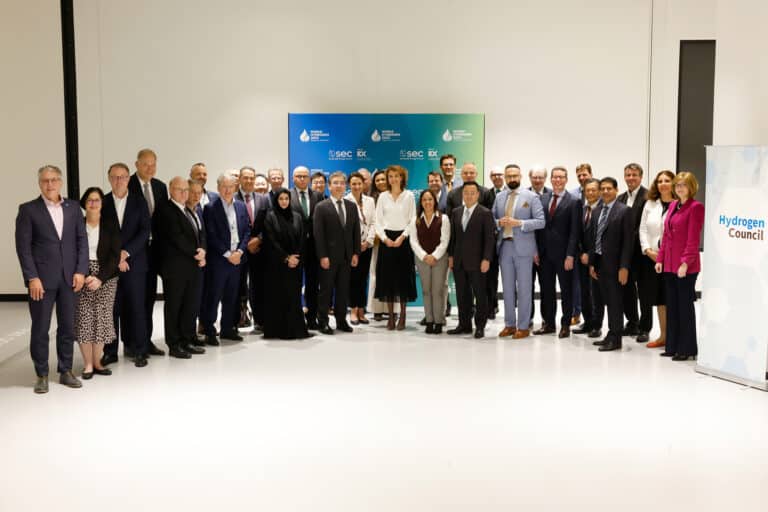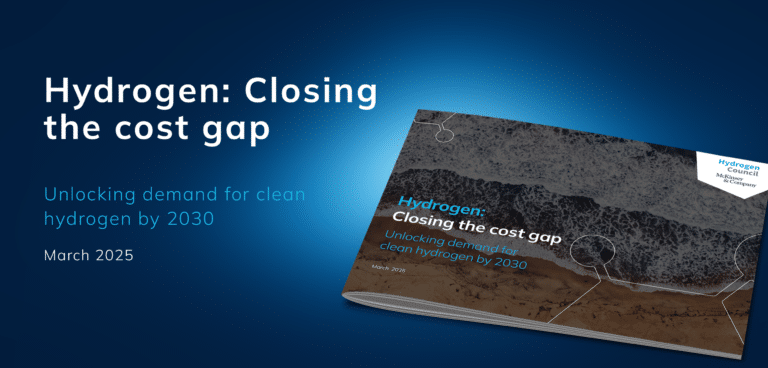The Hydrogen Council and the World Bank today released a new report, Sufficiency, Sustainability, and Circularity of Critical Materials for Clean Hydrogen, looking at the raw materials used in the hydrogen value chain, with a special focus on metals.
This study was informed by the data collected by the Hydrogen Council across our membership through a clean room process, covering all relevant potentially critical raw materials used in the hydrogen value chain.
The key conclusion from the study is that the scale of the raw materials impact of hydrogen and fuel cell technologies is small, relative to the scale of both current demand for critical raw materials and the outlook for projected demand in view of the energy transition imperative. This, however, does not mean the scale of critical raw materials use in the hydrogen value chain should be ignored. Adoption of frameworks such as the World Bank Group’s Climate-Smart Mining Framework can help manage the use of critical raw materials in hydrogen and fuel cells deployment, along with providing security of supply of the key critical raw materials needed for hydrogen deployment.
A further positive conclusion from the report is that the essential minerals and metals for clean hydrogen technologies will likely be in sufficient supply, have the potential to be sustainably sourced and can become part of a circular economy, with high percentage recycle recovery rates. These facts, when coupled with international cooperation on critical raw materials supply, are all good news for hydrogen.
The report also highlights that in some cases, such as platinum, the demand for minerals from hydrogen industry may actually relieve stress that could occur with the decline in demand from present uses, supporting the industry and the employment it currently offers, especially in southern Africa.
Notably, the largest absolute demand for critical raw materials, including aluminium, zinc, copper and nickel, comes from the build out of the necessary renewable energy generation capacity (i.e., wind, solar and battery technologies). Hence there will be pressure on all solution providers to reduce their mineral intensity.
The report also looks at the environmental impacts – greenhouse gas (GHG) emissions and water footprint – from sourcing the materials needed for clean hydrogen production and consumption. While at a macro-scale the overall climate and water footprints are likely to be small compared to other sectors, in order for clean hydrogen to play its full role in tackling climate change they must still be minimised by adopting sustainable practices and policies. Key among these are the increased use of recycled materials, innovations in design in order to reduce material intensities, and adoption of policies from the World Bank’s Climate-Smart Mining Framework.
Tom Linebarger, Executive Chairman and Chairman of the Board of Cummins Inc. and Co-Chair of the Hydrogen Council, said, “A close collaboration between the hydrogen and mining sectors will be needed to maintain the supply chain and ultimately ensure a successful transition to a low-carbon economy.”
Yoshinori Kanehana, Chairman of Kawasaki Heavy Industries, Ltd. and Co-Chair of the Hydrogen Council, said, “The future pressure on raw materials caused by hydrogen technologies, while not critical on its own merits, needs to be considered in the context of the overall future demand for these materials. Innovation will continue to reduce the material intensity of hydrogen technologies.”
Demetrios Papathanasiou, World Bank Global Director for Energy and Extractives, commented, “Our new report is another arrow in our quiver to chart a sustainable path for producing materials critical to scaling up clean hydrogen and achieving the global energy transition.”
For the study, the Hydrogen Council industry participants contributed insight into material consumption and opportunities for thrifting (reduction of usage). The mining industry participants contributed their insights into global reserves and enhancing recovery technologies.
The report’s model was built on previous publications of the World Bank’s Climate-Smart Mining Initiative, which was established five years ago with an eye towards helping resource-rich developing countries benefit from the increasing demand for minerals and metals associated with the energy transition, while ensuring the mining sector is managed in a way that minimises its environmental and climate footprint.
The full Sufficiency, Sustainability, and Circularity of Critical Materials for Clean Hydrogen report is available here.
About The Hydrogen Council
The Hydrogen Council is a global CEO-led initiative that brings together leading companies with a united vision and long-term ambition for hydrogen to foster the clean energy transition. The Council believes that hydrogen has a key role to play in reaching our global decarbonization goals by helping to diversify energy sources worldwide, foster business and technological innovation as drivers for long-term economic growth, and decarbonize hard-to-abate sectors.
Using its global reach to promote collaboration between governments, industry and investors, the Council provides guidance on accelerating the deployment of hydrogen solutions around the world. It also acts as a business marketplace, bringing together a diverse group of 140+ companies based in 20+ countries across the entire hydrogen value chain, including large multinationals, innovative SMEs, and investors.
The Hydrogen Council also serves as a resource for safety standards and an interlocutor for the investment community, while identifying opportunities for regulatory advocacy in key geographies.
To find out more visit www.hydrogencouncil.com and follow us on Twitter @HydrogenCouncil and LinkedIn.
Media Enquiries
Joanna Sampson, Communications Manager, Hydrogen Council
joanna.sampson@hydrogencouncil.com



